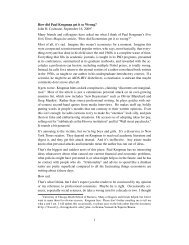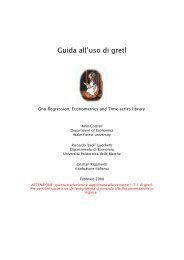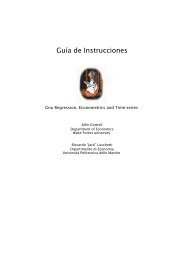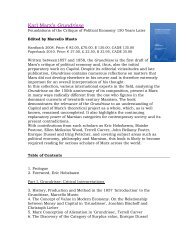The Labor Market of the Early Roman Empire - Wake Forest University
The Labor Market of the Early Roman Empire - Wake Forest University
The Labor Market of the Early Roman Empire - Wake Forest University
Create successful ePaper yourself
Turn your PDF publications into a flip-book with our unique Google optimized e-Paper software.
530 | PETER TEMIN<br />
ancient working conditions, for both free and slave workers, illustrate<br />
<strong>the</strong> operation <strong>of</strong> this uni ed labor market.<br />
Modern American slavery was a closed system. <strong>The</strong> New<br />
World slaves did not enter Eurocentric American society on easy<br />
terms; <strong>the</strong>ir opportunities were severely limited. <strong>The</strong>ir descendants<br />
in <strong>the</strong> United States are still awaiting complete integration<br />
into society. <strong>The</strong> descendants <strong>of</strong> former African slaves have fared<br />
much better in Brazil, where manumission was more frequent.<br />
Even in Brazil, however, slaves only began to be freed with any<br />
regularity in <strong>the</strong> nineteenth century when pressure for <strong>the</strong> abolition<br />
<strong>of</strong> slavery rose. Yet, since freed slaves were still excluded by<br />
former Europeans, few positive incentives were available to<br />
<strong>the</strong>m. 32<br />
<strong>The</strong> frequency with which Greek slaves were set free is unknown,<br />
but freed slaves in A<strong>the</strong>ns did not become members <strong>of</strong><br />
Greek society. <strong>The</strong>y inhabited “a limbo world in which full political<br />
and economic membership <strong>of</strong> <strong>the</strong> community was denied<br />
<strong>the</strong>m.” Unlike A<strong>the</strong>nian citizenship, <strong>Roman</strong> citizenship was inclusive.<br />
This fundamental difference between <strong>the</strong> two may have<br />
determined how each society interpreted slavery. In any case, <strong>the</strong><br />
prevalence and visibility <strong>of</strong> manumission among <strong>Roman</strong> slaves<br />
made <strong>Roman</strong> slavery far different than slavery in A<strong>the</strong>ns. 33<br />
By <strong>the</strong> time <strong>of</strong> <strong>the</strong> Principate, most slaves were probably<br />
slaves from infancy, ei<strong>the</strong>r as <strong>the</strong> children <strong>of</strong> slaves or unwanted<br />
children <strong>of</strong> free parents, since captives were few by <strong>the</strong>n. A debate<br />
about whe<strong>the</strong>r slaves were replenished through reproduction or<br />
maintained through foundlings and <strong>the</strong> slave trade persists, but<br />
most scholars agree that <strong>the</strong> supply <strong>of</strong> captives had dwindled.<br />
32 <strong>Roman</strong> slavery shared attributes with ano<strong>the</strong>r modern institution, indentured service.<br />
Poor Englishmen who wanted to emigrate to North America in <strong>the</strong> eighteenth century but<br />
could not afford it <strong>of</strong>ten mortgaged <strong>the</strong>ir future labor to pay for <strong>the</strong>ir passage. Indentures<br />
lasted a xed number <strong>of</strong> years, <strong>of</strong>ten fewer than ve, and immigrants were able to resume life<br />
without stigma after <strong>the</strong>ir indenture was nished. While indentured, however, immigrants<br />
could not move, choose occupations, or even determine <strong>the</strong> certain particulars <strong>of</strong> <strong>the</strong>ir circumscribed<br />
lives. <strong>The</strong>y were, in a descriptive oxymoron, short-term slaves. David W.<br />
Galenson, White Servitude in Colonial America (Cambridge, 1981).<br />
33 Garnsey, Ideas <strong>of</strong> Slavery, 7. A few older ancient historians noted <strong>the</strong> comparatively benign<br />
quality <strong>of</strong> ancient slavery, although without referring to manumission and without distinguishing<br />
between Greek and <strong>Roman</strong> slavery. If Greek slavery was more similar to <strong>Roman</strong><br />
than to modern slavery, featuring reduced positive incentives <strong>of</strong> an open slave system, <strong>the</strong> reason<br />
is by no means obvious. See Alfred Zimmern, “Was Greek Civilization Based on Slave<br />
<strong>Labor</strong>?” Sociological Review, II (1909), 1–19, 159–176 (repr. in idem, Solon and Croesus [London,<br />
1928]); A. H. M. Jones, “<strong>The</strong> Economics <strong>of</strong> Slavery in <strong>the</strong> Ancient World,” Economic History<br />
Review, IX (1956), 185–204.







